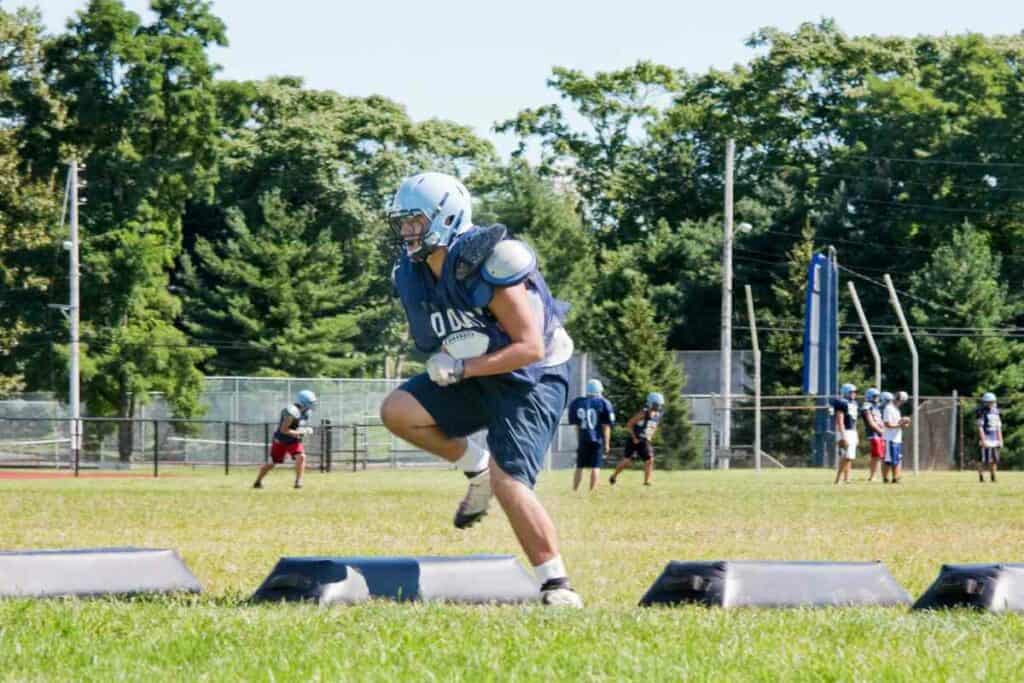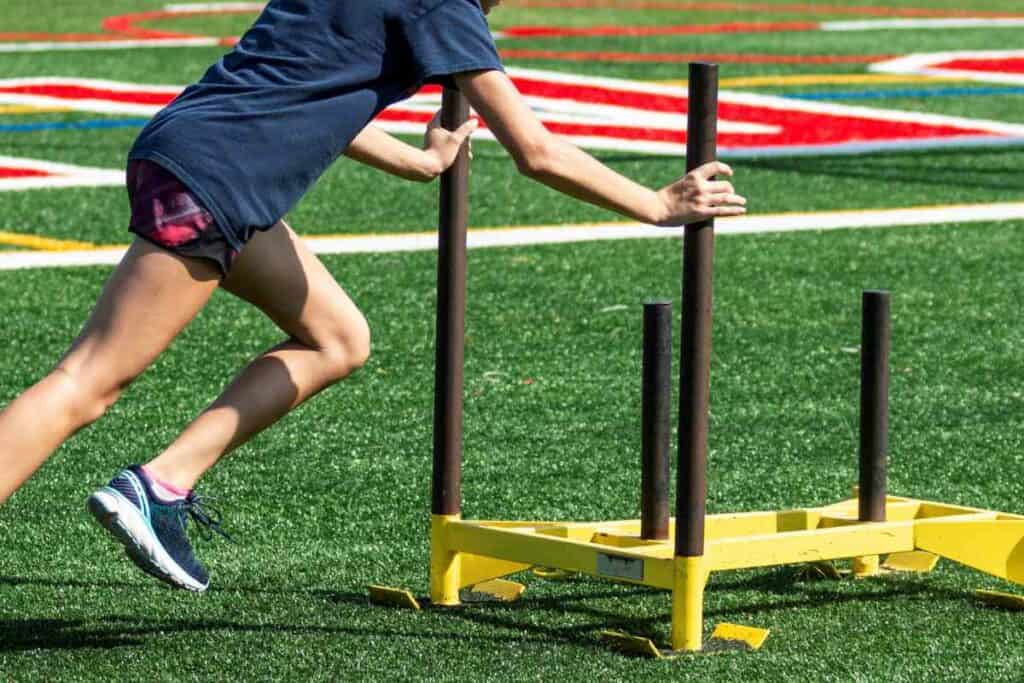How Strong is the Average High School Football Player: Unveiling Teen Athletes’ Strength Levels
High school football players display a diverse range of strength capacities, shaped by factors such as age, the position they play, and their experience with training.

Related Post! How Strong Is The Average College Football Player?
How Strong Is The Average High school Football Player?
The average high school football player exhibits strength levels significantly above those of non-athlete peers, with specific benchmarks varying by position. For example, varsity offensive and defensive linemen might squat around 405 pounds, with benchmarks for bench press and cleans also reflecting their rigorous, sport-specific training and conditioning routines.
The strength requirements of a lineman, for instance, starkly contrast with those of a wide receiver or quarterback, each role demanding specialized physical attributes and skills. Through dedicated training and targeted workout plans, these young athletes strive to meet and surpass the benchmarks of strength for their level, evolving from their freshman year through to varsity and, for some, into college football.
The measure of a high school football player’s strength transcends the mere figures achieved in the weight room. It encompasses their physical makeup, the efficiency of their training routines, the impact of nutrition and recovery on their performance, and their comparison against peers and established standards by conditioning coaches. In the competitive realm of high school football, the pursuit of continual strength enhancement is key, not just for superior performance but also for injury prevention.
Key Insights:
- Strength among high school football players varies with age and position.
- Comprehensive training and nutritional strategies are essential for performance improvement.
- Strength assessments are critical for tracking development and minimizing injury risks.
Physical Composition of High School Football Players
High school football players’ physiques are tailored to optimize their performance for their specific field positions, varying widely in height, weight, and strength.

Average Height and Weight:
- Freshmen: Heights range from 5’7″ to 5’9″, with weights between 130-160 pounds.
- Sophomores: Stand about 5’8″ to 5’10” tall, weighing around 140-180 pounds.
- Juniors: Tend to be between 5’9″ to 6’1″, with weights of 150-200 pounds or more, influenced by their workout routines.
Strength Benchmarks:
To provide perspective, here are typical strength levels by class:
- Freshmen: Bench Press 135-155 lbs, Squat up to 225 lbs, Power Clean 95-115 lbs
- Sophomores: Bench Press 160-185 lbs, Squat up to 275 lbs, Power Clean 120-135 lbs
- Juniors: Bench Press 185-205 lbs, Squat up to 315 lbs, Power Clean 140-155 lbs
Position-Specific Characteristics:
- Linemen often have larger, stronger builds, especially in their lower bodies, to generate the explosive power needed for offensive and defensive plays.
- Wide receivers and defensive backs, contrastingly, exhibit leaner figures with emphasis on agility and speed, prioritizing lower body strength for velocity and jump capability over raw power.
This nuanced understanding of strength in high school football highlights the importance of position-specific training and the role of comprehensive athletic development in fostering field performance and safety.
Related Post! Should I Play High School Football?
Strength Training Regimens
High school football players’ journey to gaining strength is intricately tied to their commitment to tailored training programs. By focusing on specific exercises and strategic planning throughout the year, significant improvements can be achieved.

Core Training Essentials
The core, being the body’s central powerhouse, plays a pivotal role in ensuring stability and strength on the field. Key exercises include:
- Squats: Fundamental for enhancing lower body strength, targeting the quads, hamstrings, and glutes.
- Deadlifts: Foster overall body power and teach safe heavy lifting techniques.
- Bench Press: Boosts upper body strength, vital for effective blocks and tackles.
- Power Cleans: Enhances explosive power and coordination across the body.
Related Post! How Often Do High School Football Players Have Practice?
Training Seasons Breakdown:
Off-Season Focus: The off-season is dedicated to muscle building and strength enhancement through heavier lifting and fewer repetitions.
- Typical Weekly Plan:
- Day 1: Upper Body Strength
- Day 2: Lower Body Power
- Day 3: Rest or Active Recovery
- Day 4: Comprehensive Conditioning
- Day 5: Agility and Speed Training
In-Season Goals: The in-season regimen aims to maintain off-season gains with reduced workload to avoid fatigue and overtraining.
- Weekly Routine:
- Day 1: Light Upper Body
- Day 2: Moderate Lower Body
- Day 3: Game Day
- Day 4: Active Recovery
- Day 5: Light Full Body Workout
Related Post! High School Football Season Length: Understanding The Timeline And Structure
Nutrition and Recovery Insights
Dietary Strategy: Optimal performance is supported by a diet as strategic as the game plan, focusing on carbohydrates for energy, proteins for muscle recovery, and fats for sustained activities.

- Suggested Daily Meals:
- Breakfast: Whole grain cereal with milk and a banana
- Lunch: Turkey sandwich on whole wheat, salad, yogurt
- Pre-Practice: Protein-rich fruit smoothie
- Post-Practice: Grilled chicken, brown rice, vegetables
- Dinner: Baked salmon, quinoa, mixed greens
Rest and Injury Prevention
Equally as important as physical training, rest and recovery strategies are crucial for overall performance and injury prevention.
- Rest Recommendations:
- Maintain consistent sleep schedules
- Incorporate active recovery to minimize overtraining
- Employ cooldown routines to lessen muscle soreness
- Injury Prevention Tips:
- Always warm up before activities
- Incorporate flexibility exercises like stretching or yoga
- Stay hydrated consistently
By following these comprehensive training, nutrition, and recovery protocols, high school football players can significantly bolster their strength and endurance, preparing them for the demands of the game while minimizing the risk of injury.
Related Post! How Long Are High School Football Games?
Comparative Strength Analysis
Analyzing the strength of high school football players involves comparing them not only with collegiate athletes but also with their non-athletic peers, highlighting a distinct disparity in physical development and training discipline.

High School vs. Collegiate Players
Strength conditioning is fundamental across all football levels. High school athletes start with foundational strength and conditioning programs, with varsity offensive and defensive linemen, for instance, reaching squat benchmarks around 405 pounds.
This figure notably increases at the collegiate level, particularly in Division I, where the expectation for the same positions can escalate to a minimum squat of 455 pounds, underscoring the enhanced training and physical growth within the college sports ecosystem.
- High School (Varsity OL/DL):
- Squat: 405 lbs
- Clean: 225 lbs
- Bench: 295 lbs
- College (Division I OL/DL):
- Squat: 455 lbs
- Clean: 275 lbs
- Bench: 365 lbs
High School vs. General Teen Population
The strength contrast between high school football players and the general teenage population is stark. While football players undergo rigorous, sport-specific strength training, most teenagers do not participate in comparable fitness routines, positioning athletes significantly above their non-athlete counterparts in strength metrics.
- High School Football Player: Exhibits superior strength and conditioning, adhering to regular, sport-centric training.
- General High School Teen: Presents a broader range of average strength, typically absent of structured athletic training.
This dedicated focus on strength development not only gears high school football players for higher levels of competition but distinctly sets them apart from their non-engaged peers.
Testing and Measurement
To accurately assess high school football players’ strength, structured testing and measurement strategies are employed, shedding light on their physical standing relative to sport-specific demands and peer benchmarks.

Common Strength Assessment Tools:
- One Rep Max (1RM): Identifies the maximum weight an athlete can lift in a single repetition.
- Isokinetic Dynamometry: Offers insights into muscle strength, highlighting balance and symmetry across muscle groups.
- Vertical Jump: Measures lower body explosive power through jump height analysis.
These assessments are crucial for tracking athletic progression, enabling tailored training adjustments and providing a comparative analysis against established norms, such as those documented in strength and conditioning research.
Importance of Performance Metrics:
Performance metrics play a vital role in understanding an athlete’s development, allowing for:
- Progress Tracking: Monitoring strength improvements to guide future training initiatives.
- Normative Benchmarking: Comparing athlete performance against established standards to evaluate potential and direct conditioning efforts.
Such data-driven approaches offer a comprehensive view of an athlete’s capabilities, forming a critical component of the broader dialogue around sports performance and future prospects.
